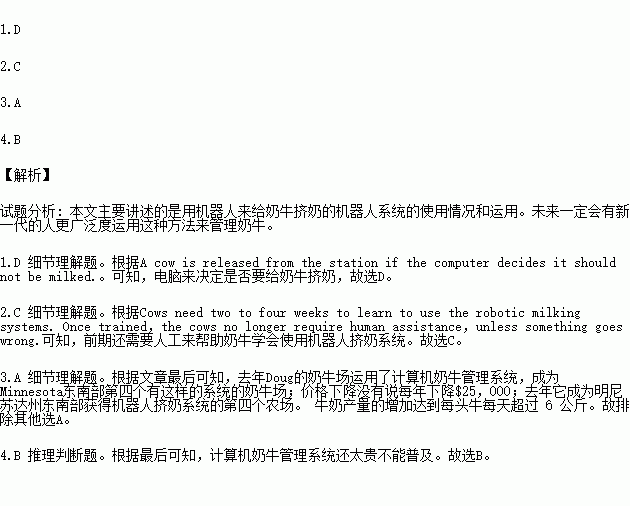题目内容
Technology is making life easier for some dairy farmers. They use robotic systems to milk their cows. These systems are designed to reduce labor and increase milk production.
Cows are trained to follow a series of paths that lead to the milking stations. Only one cow at a time can enter the station. Once inside,the cow is rewarded with food. As the cow eats,a robotic arm cleans and connects the animal to the milking machine. A few minutes later,the milking is completed. The gate is lifted. The cow leaves and the next cow enters. The robotic systems are designed to operate twenty four hours a day. Cows are milked on average about three times a day. Some are milked four to six times a day. The cows wear collars(颈圈) around their necks that identify them to the system. A computer keeps records on their eating and milking. A cow is released from the station if the computer decides it should not be milked. The system also measures the temperature and color of the freshly produced milk. Milk is thrown away if it does not pass the tests. Cows need two to four weeks to learn to use the robotic milking systems. Once trained,the cows no longer require human assistance,unless something goes wrong.
Professor Plaut heads the Department of Animal Science at Michigan State University. She believes the systems will attract especially the next generation of farmers who are more interested in technology and less interested in working all the time on the farm. Still,she says the price of robotic milking systems will continue to limit their use. Doug Suhr has more than one hundred milking cows on his farm. Last year it became the fourth farm in southeast Minnesota to get a robotic milking system. A recent story in a local agricultural newspaper said the first robot cost $175,000 and the second cost $150,000.Doug says the increase in milk production reaches a high of more than 6kg per cow per day.
1.Under robotic milking systems,______ decide(s) whether a cow is suitable to be milked.
A.the robotic arms B.the dairy farmers
C.the cows themselves D.a computer
2.When is human assistance needed during the milking?
A.When the cows enter the milking station every morning.
B.When a robotic arm connects a cow to the milking machine.
C.When the cows are trained to use the robotic milking system in the first two to four weeks.
D.When the temperature and color of the freshly produced milk are measured.
3.Which of the following statements is TRUE according to the last paragraph?
A.Since Doug got the robotic milking system,milk production on his farm has increased.
B.The price of milking machines decreases $25,000 every year.
C.Doug has the largest farm in southeast Minnesota.
D.There are four farms in southeast Minnesota that have robotic milking systems so far.
4.It can be inferred from the passage that ________.
A.the price of robotic milking systems will greatly decrease
B.robotic milking systems are still too expensive to be popular
C.most farmers are too old to use robotic milking systems
D.robotic milking systems don't need to work at night


 . the Internet is playing a key role
. the Internet is playing a key role